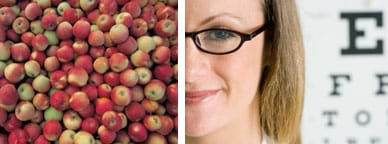Quick Look
Grade Level: 8 (8-10)
Time Required: 45 minutes
Lesson Dependency: None
Subject Areas: Biology, Physical Science

Summary
Students are introduced to an engineering challenge in which they are given a job assignment to separate three types of apples. However, they are unable to see the color differences between the apples, and as a result, they must think as engineers to design devices that can be used to help them distinguish the apples from one another. Solving the challenge depends on an understanding of wave properties and the biology of sight. After being introduced to the challenge, students form ideas and brainstorm about what background knowledge is required to solve the challenge. A class discussion produces student ideas that can be grouped into broad subject categories: waves and wave properties, light and the electromagnetic spectrum, and the structure of the eye.Engineering Connection
Engineers use the properties of waves and light in the design of tools that we use every day, including eyeglasses, security systems, and communication systems. An ultra-fast device that uses light for communication between chips (like those found in computers and other electronic instruments) has enabled the design of even speedier computers.
Through this legacy cycle lesson, students are introduced to an engineering challenge and then asked to brainstorm solutions to it (challenges and generates ideas phases). Like engineers, students first identify the need and then determine the issues that must be considered in the design. Before moving to the research and revise phase of the legacy cycle, students must identify the information they need to acquire to solve this challenge. Engineers in all fields routinely follow the engineering design process, and this first step often proves to be the most critical in finding workable solutions.
Learning Objectives
After this lesson, students should be able to:
- Identify information necessary to solve a challenging problem.
- Group together similar areas of knowledge needed to solve a challenging problem.
Educational Standards
Each TeachEngineering lesson or activity is correlated to one or more K-12 science,
technology, engineering or math (STEM) educational standards.
All 100,000+ K-12 STEM standards covered in TeachEngineering are collected, maintained and packaged by the Achievement Standards Network (ASN),
a project of D2L (www.achievementstandards.org).
In the ASN, standards are hierarchically structured: first by source; e.g., by state; within source by type; e.g., science or mathematics;
within type by subtype, then by grade, etc.
Each TeachEngineering lesson or activity is correlated to one or more K-12 science, technology, engineering or math (STEM) educational standards.
All 100,000+ K-12 STEM standards covered in TeachEngineering are collected, maintained and packaged by the Achievement Standards Network (ASN), a project of D2L (www.achievementstandards.org).
In the ASN, standards are hierarchically structured: first by source; e.g., by state; within source by type; e.g., science or mathematics; within type by subtype, then by grade, etc.
NGSS: Next Generation Science Standards - Science
-
The uses of technologies and any limitations on their use are driven by individual or societal needs, desires, and values; by the findings of scientific research; and by differences in such factors as climate, natural resources, and economic conditions.
(Grades 6 - 8)
More Details
Do you agree with this alignment?
-
Ask questions that can be investigated within the scope of the classroom, outdoor environment, and museums and other public facilities with available resources and, when appropriate, frame a hypothesis based on observations and scientific principles.
(Grades 6 - 8)
More Details
Do you agree with this alignment?
International Technology and Engineering Educators Association - Technology
-
Students will develop an understanding of the role of troubleshooting, research and development, invention and innovation, and experimentation in problem solving.
(Grades
K -
12)
More Details
Do you agree with this alignment?
-
Students will develop an understanding of the relationships among technologies and the connections between technology and other fields of study.
(Grades
K -
12)
More Details
Do you agree with this alignment?
State Standards
South Carolina - Science
-
Waves (including sound and seismic waves, waves on water, and light waves) have energy and transfer energy when they interact with matter. Waves are a repeating pattern of motion that transfers energy from place to place without overall displacement of matter. All types of waves have some features in common. When waves interact, they superimpose upon or interfere with each other resulting in changes to the amplitude. Major modern technologies are based on waves and their interactions with matter.
(Grade
8)
More Details
Do you agree with this alignment?
Worksheets and Attachments
Visit [www.teachengineering.org/lessons/view/clem_waves_lesson01] to print or download.Introduction/Motivation
(In advance, make copies of the attached Collecting the Clues Worksheet, enough for one per student.)
Have you ever wondered if everyone sees the world in the same way you do? Or why some people seem to be unable to match colors? Have you ever wondered how the eye works? Or what allows us to see different colors? What if this happened:
You just got your first job. You are now a stock person in the new Food Lion. You show up for your first day of work excited and ready to prove how good a worker you are. The manager greets you and assigns your first task. He takes you back to the delivery entrance and you see cases and cases of apples sitting on the loading dock. The manager waves his hand over the entire mess, and says, "These need to be put into the cooler. Separate the boxes by apple type and put the Granny Smiths on the left side, the Golden Delicious in the middle, and the Red Delicious on the right. Then put some of each out in the store in the produce section." Before you can ask any questions, an urgent summons for the manager comes over the intercom system and he rushes off. You look at the cases and see no labels on the boxes. "No problem," you say to yourself. "I'll just look in the boxes to see what's what." So you look in the boxes. However, you only see two different colors of apples, not three. The only identifying feature they have are numbers on stickers. Just as you are about to panic, another worker walks by. "How do you tell the difference between Granny Smith, Golden Delicious, and Red Delicious apples?" you ask him. He gives you a strange look and says, "The Granny Smiths are green, the Golden Delicious are yellow, and the Red Delicious are red. Duh!" You think to yourself: Why can't I see three colors? Is it my eyes, or something else that affects how we are able to see? Can you apply engineering principles to design a device that could be used to help distinguish these three colors from one another?
Over the next classes, it is our task to solve the mystery of why you cannot see all three colors. and work as engineers to figure out what could be used to overcome this problem.
Are you ready to solve this mystery and engineer solutions to it?!? To accomplish our goal, we must begin the engineering design process by first considering what we already know and determine what we think we must learn. Then, we will put all our ideas together and group them into broad categories. After exploring our initial ideas, we will spend a few days learning about the properties of waves and light in addition to the structure of the eye. So, after just a few classes, we will have an understanding of light and the eye so we can engineer solutions! Let's get started!
Today, let's begin to consider and record our initial thoughts in response to the three-color mystery. First, it is important to consider the background knowledge we already have that can help us solve this mystery. Then, we need to consider what information we need to learn to accurately solve the challenge. I am passing out a worksheet that I would like each of you to complete, first by yourself and then in small groups to expand your ideas.
(Hand out the worksheets. Give students time to record their personal thoughts and ideas on the worksheets. Then, divide the class into groups of two or three students each, and have them share their ideas. Walk around the classroom and make sure that everyone in each group is participating. When everyone in the small groups has shared their individually generated ideas, come back together as a class. Next, have the class generate a list of concepts on the board to consider in solving the challenge question. From the list on the board, have students categorize the concepts into three knowledge areas: waves and wave properties, light and the electromagnetic spectrum, and the structure of the eye.)
These are the knowledge areas that we will focus on throughout this wave properties unit. Gathering this information and conducting this research will help us solve our challenge question!
Lesson Background and Concepts for Teachers
Legacy Cycle Information: This lesson covers the challenge and generates ideas phases of the legacy cycle, during which students begin to compile their current knowledge, ideas and perceptions that they think are necessary to solve the challenge. Begin by briefly introducing students to the legacy cycle and how it applies to the unit. The purpose of this introduction is to help students understand why they are going through each phase of the cycle, and help them see how it relates to the engineering design process.
Vocabulary/Definitions
electromagnetic spectrum: The range of all possible frequencies of electromagnetic radiation
wave: A disturbance that travels through space and time, and transfers energy
Assessment
Participation Grade: While students compile their thoughts, consider students' individual contributions in calculating their daily participation grades.
Worksheet: Have students complete the Collecting the Clues Worksheet. Review their answers to gauge their understanding of the material covered.
Subscribe
Get the inside scoop on all things TeachEngineering such as new site features, curriculum updates, video releases, and more by signing up for our newsletter!More Curriculum Like This

Students learn about the types of waves and how they change direction, as well as basic wave properties such as wavelength, frequency, amplitude and speed. During the presentation of lecture information on wave characteristics and properties, students take notes using a handout.

Students learn about the basic properties of light and how light interacts with objects. They are introduced to the additive and subtractive color systems, and the phenomena of refraction. Students further explore the differences between the additive and subtractive color systems via predictions, ob...

Students learn the basics of the electromagnetic spectrum and how various types of electromagnetic waves are related in terms of wavelength and energy. In addition, they are introduced to the various types of waves that make up the electromagnetic spectrum including, radio waves, ultraviolet waves, ...

Students learn about the anatomical structure of the human eye and how humans see light, as well as some causes of color blindness. They conduct experiments as an example of research to gather information.
Copyright
© 2013 by Regents of the University of Colorado; original © 2010 Clemson UniversityContributors
Ellen Zielinski; Courtney FaberSupporting Program
Research Experience for Teachers (RET) Program, Center of Advancement of Engineering Fibers and Films, Clemson UniversityAcknowledgements
This lesson was developed through Clemson University's "Engineering Fibers and Films Experience – EFF-X" Research Experience for Teachers program, funded by National Science Foundation grant no. EEC-0602040. However, these contents do not necessarily represent the policies of the National Science Foundation, and you should not assume endorsement by the federal government.
Last modified: December 9, 2020









User Comments & Tips